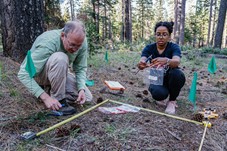Spotlight on Faculty — Jim Randerson’s flair for forests
It sounds good in theory. It seems like a relatively easy way to sequester carbon using our woodlands. Corporations could purchase carbon credits from landowners who preserve the forested areas on their property. And on paper, carbon offsets appear to balance out a company’s carbon emissions: the company pays to protect trees, which absorb carbon dioxide from the air, reducing the company’s net impact on the climate.
Jim Randerson and his research team tramp through California’s forests, collecting data as they go—data which is used to analyze and monitor many aspects of woodlands management, such as the effects of drought, logging, fires, and disease on the health of our forested lands.
He is an expert in this field, relied upon by the U.S. Forest Service, the California Air Resources Board, and other agencies to provide up-to-date research findings and help inform best practices for woodlands maintenance. However, in the practice of forest offsets, his recent satellite analysis reveals what researchers have suspected for years: the program might not be doing much for the climate.
The findings shed a new, realistic light on California’s efforts to control climate change. Many companies enrolled in the state’s program by investing in vast swaths of forests to recapture carbon, and now claim “net-zero” emissions for their businesses. However, many offset sites are owned and operated by large timber companies, which continue their logging operations. Past studies have shown that these offset projects are often given greater credit than is merited and, in this case, Jim’s team has found a larger issue: the lack of real benefit to the climate over the 10 years since the program’s inception.
 California has one of the world’s largest carbon offset programs, with tens of millions of dollars flowing through offset projects, and is often a model for other countries that are planning new offset programs. Forest offsets and other “natural climate solutions” have received a great deal of attention from companies, governments, and nonprofits, including during the 2022 United Nations climate conference in Egypt. Large oil and gas companies use offsets to meet up to 8% of their state-mandated reductions in emissions. Offsets are playing a large and growing role in climate policy, and they need to be backed by the best available science.
California has one of the world’s largest carbon offset programs, with tens of millions of dollars flowing through offset projects, and is often a model for other countries that are planning new offset programs. Forest offsets and other “natural climate solutions” have received a great deal of attention from companies, governments, and nonprofits, including during the 2022 United Nations climate conference in Egypt. Large oil and gas companies use offsets to meet up to 8% of their state-mandated reductions in emissions. Offsets are playing a large and growing role in climate policy, and they need to be backed by the best available science.
Jim's team, including grad student Audrey Odwuor shown here, conduct field studies and sampling at numerous forest locations throughout California. However, satellites offer a more complete record than on-the-ground reports collected at offset projects. Their data allows assessment of the entire state of California since 1986, both before and after the offset program began in 2012. Jim’s study used this satellite data to track forest biomass, tree harvesting rates, and tree species in offset projects compared with other similar forests in California. The Randerson team found that forest biomass isn’t increasing in the state’s 37 offset project sites any more than in other areas, and timber companies aren’t logging less than they did before companies invested in protecting that land.
In some regions, projects are located on lands with lower-value tree species that aren’t at risk from logging. For example, at one large timber company in the redwood forests of northwestern California, the offset project is only 4% redwood, compared with 25% redwood on the rest of the company’s property. The offset project’s area is overgrown with tanoak, which is not marketable timber and doesn’t need to be protected from logging.
Without improvements to the current system, we underestimate California’s net emissions, contribute to the profits of large landowners and greenhouse gas emitters, and distract from the real solutions that come from transitioning to a clean-energy economy. Jim’s research prompts him to offer several recommendations for California to improve its offsets protocols.
- Utilize satellite data to monitor forests and confirm that they are being managed to protect trees or store more carbon. This data is publicly available and should make carbon offsetting more reliable and transparent.
- Avoid putting offset projects on lands that are already being conserved. Jim’s team found several projects owned by conservation groups on land that already had low harvest rates.
- Update and improve the protocols for California’s offset contracts to make sure landowners can’t withdraw from an offset program in the future and cut down those trees. Currently there is a penalty for doing so, but it might not be high enough. Landowners could begin a project, receive a huge profit from the initial credits, then cut down the trees in 20 to 30 years, paying the penalty at that time in dollars that are likely to be worth less because of inflation.
- Require offset projects to build in a larger buffer to account for the warming climate. The state requires only 2% or 4% of carbon credits be set aside in an insurance pool against wildfires, even though multiple projects have been damaged by recent fires. The pool may soon be depleted as yearly burned area increases in a warming climate. The insurance pool must be large enough to cover worsening droughts, wildfires, and disease and beetle infestations.
- Once they have a clear-eyed view of how forest offsets work—or don’t—policy makers should consider investing in other climate-mitigation measures, like solar and electrification projects in low-income urban areas: these efforts may provide more cost-effective, reliable, and just outcomes.
In addition to this, Jim’s other recent studies have focused on such topics as the effects of El Nino on Amazon basin forests, the burn rate of forest debris in a controlled burn, the expansion of Valley Fever in the western U.S. due to a rise in temperatures, quantifying the loss of trees throughout California forests, measuring the impacts of deforestation, and changes in Arctic and boreal ecosystems.
He is frequently interviewed by media and publications on his research, and his findings and projections are well known to agencies charged with the formation of climate and land use policy. We can be sure that Jim will continue his efforts to preserve and protect our woodland areas.
This article borrowed heavily from the November 29, 2022 Los Angeles Times Op-Ed written by Jim and his graduate student Shane Coffield, now a postdoctoral scientist in biospheric sciences at the NASA Goddard Space Flight Center in Greenbelt, Md.

